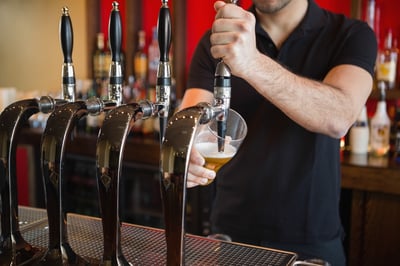This post written by Nicole Duncan and published by FSR Magazine
While not part of the traditional, three-square-meals paradigm, happy hour has proved itself a viable revenue generator in the restaurant sector. A 2018 study from Nielsen even credited happy hour with generating 60.5 percent of weekly sales at restaurants and bars and increasing the average check by $8. (It should be noted the study defined happy hour as taking place between 5 and 8 p.m., which runs much later than most programs.)
But a lot has changed since 2018. Consumers are returning to restaurants for dine- and drink-in—but they’re not necessarily going back to the office. This sea change has myriad implications for restaurants, with many lunch-centric establishments either curtailing their hours or shuttering their doors altogether.
But happy hour isn’t lunch. While the latter can be a social gathering, happy hour is almost exclusively one. Some studies suggest consumers are seeking out these occasions even more than they did before COVID.
“The happy hours themselves have not changed because of the pandemic. They are still a way for our restaurants to attract guests and start the energy earlier in the day. They are just as busy as they were before,” says Jennifer Krapp, director of restaurant operations for Charleston, South Carolina–based Indigo Road Hospitality. “I believe that with so many people working remotely now, people are craving that social interaction that they are not getting throughout the day.”
Happy hour is a common offering across Indigo Road’s 30-odd restaurants, though the approach varies by concept. For example, seven-unit O-Ku Sushi positions its happy hour around deep discounts, such as half-off rolls. “Guests’ behaviors indicate everyone loves a good deal, whether it is food or drink,” Krapp adds.
On the other hand, sister restaurant Maya uses the stretch between 5 and 6:30 p.m. to showcase playful dishes and drinks not found on the regular menu. This includes elote popcorn, Frito Pie (made with corn chips), and Ranch Water—made with Lunazul Tequila, lime, and sparkling water.
At fine casual Hopdoddy, the pre-COVID happy hour served multiple purposes from a business standpoint. Vice president of revenue Matt Schweitzer breaks down the menu as follows: 50 percent showcased (and in some cases, tested) unique items that could be quickly executed; 25 percent comprised what Schweitzer describes as “brand-defining” items; and 25 percent were discounted offerings.
In the three years leading up to 2020, happy hour was the single largest growing daypart at Hopdoddy. Schweitzer credits its burgeoning popularity to several high-volume stores in densely populated areas—right in the path of professional foot traffic. Brand positioning and smooth execution then ensured its staying power.
“At the time, we were really trying to use happy hour not as a discount, because we’re not a discount brand, but as an outlet where we could get people [to try] things that were a little bit different … and really highlighted what we do and what we do really well,” Schweitzer says.
The very existence of happy hour at Hopdoddy already highlights a difference between the concept and its limited-service peers. While not unheard of, happy hours conventionally fall under the purview of full-service operations and bars. Hopdoddy, however, bucks the norm.
“Our CEO [Jeff Chandler], who’s done an amazing job describing our concept over the years, coined the term ‘unicorn casual,’ and what that means is we try to capture the best things of quick service and the best things of of fast casual and casual dining,” Schweitzer says. “Happy hour is one of those things that we wanted to grab from other sectors of the restaurant scene, and we thought that it could be a differentiator for us, given our full bar, given our service model, given our offerings.”
During the pandemic, Hopdoddy, like many other establishments, stopped its happy hour. Now, plans are in the works to bring it back but with a fresh, new look. Schweitzer won’t go into much detail but explains that the brand is stepping outside its comfort zone. Guests should expect culinary innovation and speed of service to be at the forefront of the new program. 
“We’re going to do everything and anything we possibly can to ensure our bars are packed to the rafters. We want our bars to be so busy that we have to increase staffing. We want there to be lines, and we want people handing drinks back to their friends behind them because people are fighting for seats at the bar,” Schweitzer says. “Our goal is to be big and bold, to make a statement and put our stake in the ground. We’re going to have the best happy hour in the market and we want to be the local happy hour dining establishment of choice.”
Back on the full-service side, Xperience Restaurant Group (xrg) is also reimagining happy hour. CEO Randy Sharpe says it’s one of the most popular dayparts, attracting both regulars and new diners alike. It has also remained a key revenue driver, even in a post-COVID landscape. Late last year, XRG debuted new happy hour menus at its two flagship concepts, Chevys Fresh Mex and El Torito.
“This specific iteration of both happy hours is notable because we rarely make such extensive updates to the menu at once. These are completely new and innovative items,” Sharpe says.
New offerings now account for about a third of the two dozen–plus options on the happy hour menu. These value-driven additions include $6 Potato Chorizo Taquitos, $8 Beef Birria Tacos, and $10 Shrimp Tacos Gobernador on the food side, as well as drink specials like $4 house wine and $8 Watermelon Candy Shots.
Two of the most popular new items are the Mexican Pizza and the Margarita Flight, both clocking in at $10. Sharpe says classics like the Frozen Margarita at Chevys and Signature Margaritas in fruit flavors at El Torito “continue to be a main draw for our guests due to their consistent affordability and quality.”
For Sharpe and Krapp, happy hour’s victorious return seems imminent. But from the fast-casual point of view, Schweitzer has a more measured opinion. Since the pandemic, he’s seen fewer professionals and large groups at happy hour, but more young guests. Furthermore, he’s observed an increase in the downtime stretch between the lunch and happy hour, with the former ending earlier and the latter beginning later.
To address this, Hopdoddy is going to embrace overlap, so happy hour bleeds into dinner. The brand is also doubling down on service, which, Schweitzer predicts, has the potential to make or break the daypart.
“People don’t want to look around for service; people just want it there right now, which is kind of why we want to pack our bars,” he says. “This younger generation is definitely a crowd of immediacy. And it’s our notion that if people are having to think about wanting the next drink, we might have lost. So we’re going to try to cater our service periods, our staffing levels, and our offerings to really combat that.”



